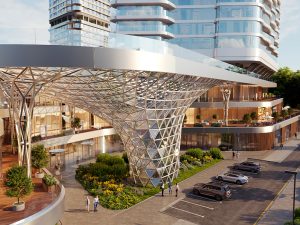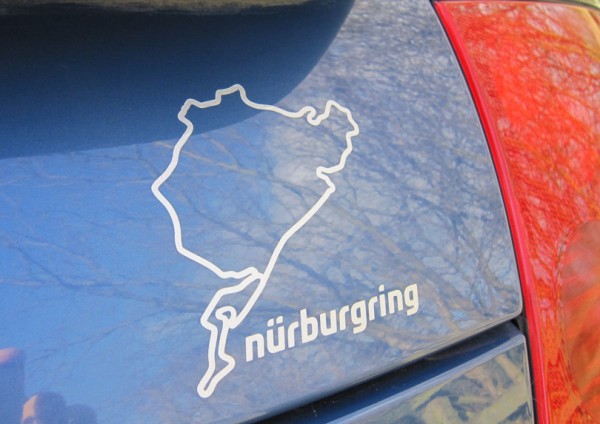The Nürburgring Nordschleife.
What is it, how do you spell it, and why do people put stickers of it onto the back of their cars?
Well, it’s a racetrack. And if you want to spell it correctly, keep in mind that the track is located in Nürburg, Germany. Not Nuremberg which is hundreds of miles away, and certainly not Nuremburg which doesn’t exist at all. It’s worth pointing out, as some people have quite literally ended up in the wrong part of Germany. Why the Ring has become the automotive Mecca of the world is going to take a bit longer to explain.
The Nürburgring is really two tracks, the old Nordschleife and the new GP track. For official races these tracks are usually linked together, as the Nordschleife lacks a proper pit lane. But even though the GP track obviously hosts the Formula One races, it really isn’t that interesting to most people. The Nordschleife on the other hand, is legendary. Its nickname: the Green Hell.
![]()
In many ways, the Nordschleife is a ghost of the past. It opened in 1927, when the idea of a safety barrier was a few straw bales stacked on top of each other. The original Circuit de Spa-Franchorchamps from 1920 was only an hour’s drive away from Nürburg, and in many ways very similar to the Ring. Both tracks were very long, 20,8 kilometers for the Nürburgring and 14,9 for Spa. Both were high speed tracks, surrounded by trees and steep hillsides but no safety barriers. This was an era where each year at least one Formula One driver died.
Eventually, both Spa and the Ring were deemed too dangerous for F1, and new tracks were built in their place. But whereas the old Spa-Franchorchamps layout was scrapped in the process of building the modern track, the Nurburgring GP circuit was built alongside the Nordschleife, leaving the old legend intact.
Only a few minor changes have been made to the Nordschleife since the 1920s. The worst bumps were removed and safety barriers were installed, but the layout has remained almost exactly the same. Which means it is still a high speed track, filled with blind corners and huge elevation changes. A fast lap time in a quick road car, say a BMW M3, is around 8 minutes. That means the average speed around the track is roughly 150 km/h, with peaks of more than 250 km/h on the long straights.
![]()
Precisely because the Nordschleife is considered to be the most challenging track in the world, car manufacturers have long been using it as a test track. If your car can be quick around the Ring, it will be quick anywhere. At first it was mostly the German brands who used the Ring, but these days just about everybody flies in to lap their sportscar prototypes. Not least, I suspect, because it can be quite good publicity. Not a week goes by without «spy shots» of camouflaged cars lapping the Ring turning up in the car press. There’s also a genuine lap time war going on between some manufacturers, who upload their record breaking laps to youtube where people who are too young to drive can then argue endlessly about them.
Still, if there is one thing which has made the Nordschleife globally famous, it must be the «Touristenfahrten». Essentially these «tourist drives» mean that anybody can turn up in their own car, buy a ticket, and go for a lap of the biggest and baddest track in the world. This wouldn’t be very extraordinary in itself, if it were not for the fact that for Touristenfahrten the Ring suddenly becomes a German public road. Which means, your car must be registered and insured, and you must adhere to the rules of traffic. This might sound like a boring thing to do on a racetrack, and it probably would be anywhere else, but not in Germany. Because Germany has the Autobahn, a highway which — in some places — has no speed limit. So, at selected times, the Nordschleife becomes a one-way highway with no speed limit. The only actual rule you need to pay attention to is that you must overtake cars on the left hand side. It is an extraordinary legal framework, and in the opinion of someone who loves cars and driving, a real feather in Germany’s cap that they are not being a nanny state about it.
This system has existed ever since the Nürburgring was built, but it wasn’t really until the 1990s that many international drivers started taking notice and making trips. And then it took even longer, until the mid-2000s, for the Ring to become truly world famous. Car magazines, and particularly the famous Top Gear TV program, started spreading the word on the existence of this utopian temple of speed in the Eiffel mountains. Once the secret was out, hundreds of thousands from all over Europe started flocking to the Ring, creating Sunday afternoon traffic jams on roads which are practically deserted during working days.
I first visited in 2004 after a friend’s invitation and what I remember most of all was the amazing collection of cars in the parking lot. It’s like stepping into a miniature universe where only fast cars exist. I also remember that I was very very slow on track. If you don’t know which way the track goes, it feels like a never ending nightmare with hills and trees obstructing your view and faster cars flying by you all the time. So it’s a good idea to study some videos beforehand, or drive the virtual track in a computer simulation. Managing traffic becomes easier as you go faster, because you don’t get overtaken as much.
![]()
Unfortunately I haven’t driven the Ring for almost 4 years now, but I’m certainly going to go back when I get the chance. I did a lot of driving there in a highly modified Volvo 850, which was hilariously good fun because you surprise other drivers with it. And it makes for nice conversations afterwards in the parking lot, with friends you never knew you had. The video below was shot in 2010, one of my last laps of the Nordschleife to this day. About halfway through I came up on a modified Ford Focus RS which was driving pretty quickly. That Focus actually used a Volvo engine similar to mine which made things more interesting. The other driver was obviously aware of my presence and a friendly little race ensued. I only found out afterwards that it was being driven by a Croatian rally driver, who still didn’t know the track too well.
If you want to visit, I would recommend avoiding the high season in summer, and try to use some of the shorter evening sessions on weekdays. That way, you avoid most of the tourists who don’t have a clue which way the track is going. You are more likely to share the track with experienced drivers, which does mean you need to watch your rear-view mirror. A «local» driver in a 911 GT3 RS is likely to be a lot faster than you regardless of what you are driving. On the Ring, track knowledge is everything. And because it is so long, with so many corners and so many different kinds of asphalt, it takes a long time to learn well. Even people who have done 1000 laps still learn something every lap.
![]()
People who crash their car usually do so after they have done a small number of laps and are starting to feel that they know the track. They start to go a little faster, push a little harder, and that’s where things go wrong. The Ring is one of those places where a local driver in a Renault Megane can be faster than a first timer in a Ferrari 458. Don’t let your ego do the driving, or it will get bruised.
After a few sessions you will probably realize that there are too many bikes, buses and outright terrible drivers on the Ring during the sessions that are open to the public. The solution to this problem is to book a Nordschleife trackday, when the track is effectively rented by a single private group. These only happen a few times each year, and costs more than a few lap tickets, but they are well worth it. I’ve driven about 200 laps of the Nordschleife, and I can honestly say I’ve never crashed. I can also say that the reason for that is pure, simple luck. I can remember several «close calls» where I could easily have crashed if things happened a bit differently. Everyone who regularly drives the Ring has these stories. It doesn’t even need to be your fault. Many corners on the Ring are blind, so you can’t see what’s on the other side as you approach at over 200 km/h. If there is an unexpected obstacle, or an oil spill, you are going to be out of luck. If you are unlucky enough to be at the wrong place at the wrong time, you will crash. Even BMW’s famous Ring Taxi — driven by professional racing drivers — has crashed on several occasions.
![]()
Keep all that in mind, drive at 85% rather than 99, and you’ll be fine. If you can’t bring your own car, there are several specialized rental companies right next to the track. You can easily fly into Cologne/Bonn airport and they’ll organize a transfer to get you to the Ring and into one of their cars. They also offer driving instruction which is highly recommended, they will be happy to show you around. When they do, just make sure you don’t eat too much beforehand.
![]()
Drive the Nordschleife and you will understand why some people travel thousands of miles just to spend a bit of time on this piece of road, at least once in their life. The scenery is stunning, the feeling of speed is immense, and you are surrounded by people who share your passion no matter which car they drive. If you love driving, it’s an experience which lives up to the hype completely. Each lap is an adventure different from the last, and discussing them afterwards with your friends in the car park is nearly as much fun as the driving itself.
![]()











